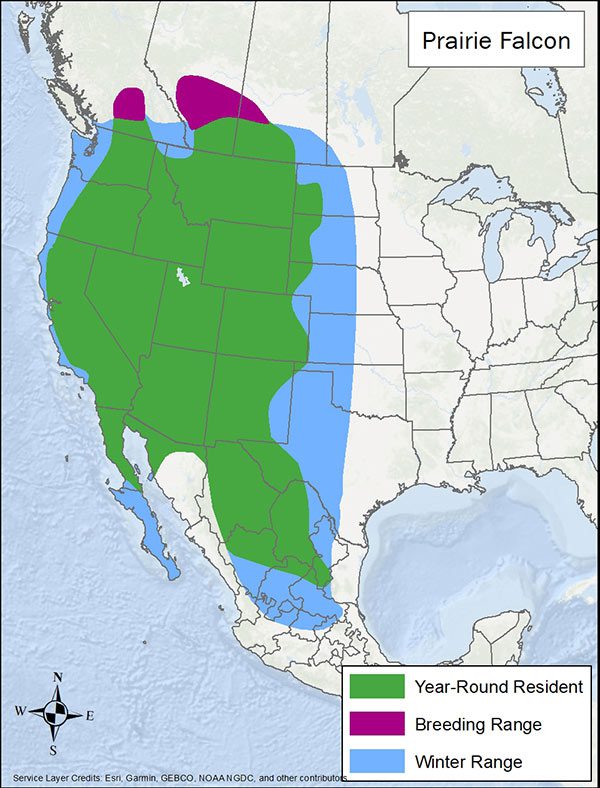LandPKS Learning
Habitat Hub

Prairie Falcon
Prairie falcon pairs are notoriously aggressive in defending their nest sites—against great horned owls, eagles, hawks, and even other prairie falcons, sometimes killing fledglings that stray into the wrong territory.
Falco mexicanus
Identification
Prairie falcons are similar to other falcons such has peregrine falcons, and are large, pale and overall brown. They are about the size of a crow at 14-18 in/37-47 cm long. They have similar facial streaks as peregrines but lighter in color (brown back, white underparts). They nest on cliff edges.
Observation Tips
Prairie falcons are found throughout the western U.S. Many are year-round residents and considered more of a “wanderer” than a true migrant. Seasonal movements reflect responses to changing food availability. Migration pattern is circular, with few individuals flying directly south to wintering areas. Most move north or east before heading south. Many individuals return to winter near their breeding areas. Look for these fairly large falcons in the open, treeless spaces of the West, where they can be dwarfed by the size of the landscape. Prairie falcons spend much of the day on the move. Watch for them cruising fairly low over the land rather than soaring high in the sky. It’s also worth scanning for low perched birds, sitting on fence posts and irrigation structures.
Interesting Fact
Prairie falcon pairs are notoriously aggressive in defending their nest sites—against great horned owls, eagles, hawks, and even other prairie falcons, sometimes killing fledglings that stray into the wrong territory.
Ideal Habitat
Prairie falcons inhabit open habitat at all elevations up to 10,990 ft/3,350 m, including shrub-steppe desert, grasslands, mixed shrub and grasslands, and alpine tundra. They occupy dry areas in the plains and steppes, wherever cliffs or bluffs are present for nesting sites. Foraging habitat is usually dominated by grasslands with dense cover, >80% and a low shrub component, <5%, but incorporates some shorter vegetation for locating prey (rodents). Nests are placed on cliff edges.

Range map provided by BirdLife International
Management Activities that Benefit Species – Best Management Practices (BMPs)
Maintain semi-open short-structured, dense grasslands and meadows with perching trees or fence posts/utility poles.
Management Activities to Avoid
The primary activities to avoid are not management oriented, but more related to human activities. Avoid conversion of native grasslands to cropland and residential development. Avoid pesticides that can remove prey available for prairie falcons. Avoid disturbance to cliff areas where they nest.
Other Species that Benefit from Similar Habitat Management
Other wildlife that may benefit from habitat management for prairie falcons include golden eagles, ferruginous and Swainson’s hawks, pronghorn antelope and American kestrels
Download
Download the Prairie Falcon factsheet
Other Resources
BirdLife International and Handbook of the Birds of the World. 2019. Bird species distribution maps of the world. Version 2019.1. Prairie Falcon
The Cornell Lab of Ornithology. Birds of the World (Prairie falcon).
The Cornell Lab of Ornithology. All About Birds (Prairie falcon).
NatureServe. 2019. NatureServe Explorer: An online encyclopedia of life [web application]. Version 7.1. NatureServe, Arlington, Virginia. Prairie falcon
USGS. Effects of management practices on grassland birds: Prairie falcon. Northern Prairie Wildlife Research Center, Jamestown, ND. 33 pages
Photography by Charles Gates, Flickr.
Mobile App | Data Portal | Knowledge Hub | Habitat Hub | Learning Collections | Blog | About | Contact | Support



